The flow chart below shows the steps required to make a Customer Specific Inventory release. Take some time to look over this chart before you start the next section of the tutorial. The steps shown with shadows are steps performed in the software, the others are manual steps.
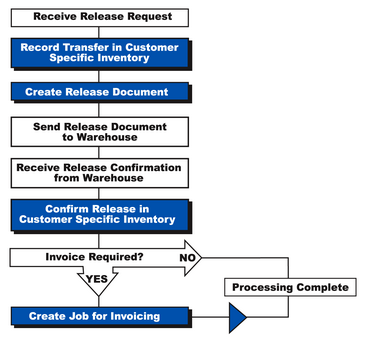
In this exercise, we are going to process a release for two items from our warehouse. The request is from Mary at ABC Plumbing Company in Massachusetts. The merchandise in our warehouse is distributor owned. We will bill the customer for each release. We do not make physical inventory counts at the Massachusetts location, so we assume that everything that gets sent to that location is used as soon as it leaves our warehouse.
Select Items and Locations for Transfer
Select Actions > Transfer from the Customer Specific Inventory Node.
Use WHS01 for the Source Location.
For the Destination Location click the ![]() button with your mouse.
button with your mouse.
Select ABC Plumbing Company – MA, Watertown, MA from the Find Code list.
Enter Mary<Tab> for the Requisition Number and select OK to continue.
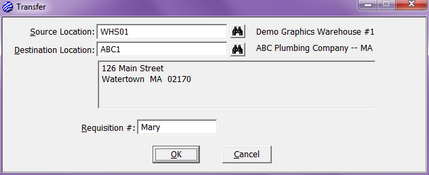
The Pick A Source Control Record dialog box is like the Search dialog box that we used earlier to find control records. Notice that the þWarehouse Location box is checked and the Warehouse is identified as WHS01. All we need to do is provide an item. For the first item, Mary told us she wanted 1 carton of their part number 99197A.
Click the Customer Item #: prompt and enter 99197A<Tab>.
Select the control record for item ABC14 from the Search Results list.
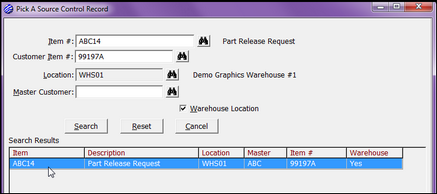
The Transfer dialog box is now shown, and we are being prompted for the Requested Quantity. Let’s take some time and look at the information available in this dialog box. First, notice the list box at the bottom. It shows what is available in our warehouse. In this case, all of the stock for this item is in the same lot, with the same cost and price, so there is only one line. The line shows the cost and price of what we have available. It also shows the carton quantity for the lot.
Also note the þ Show Used check box. This box is checked. It tells the program to immediately create a usage transaction for ABC1 for the amount of the transfer. The o Count at Site check box from the main Customer Specific Inventory window determines the status for the þ Show Used check box in the transfer. If we are not counting at site, the program assumes we want to show the item used upon transfer to the customer site.
Mary asked for 1 Carton. We look at the list and see that there are 1.2 M/CT.
Enter 1.2<Tab> for the Requested Quantity. Notice that the transfer quantity has been filled in on the list box. This is not of particular importance to us on this release, because only one lot is available. If there were multiple lots, we could see from which lot our release was pulled.
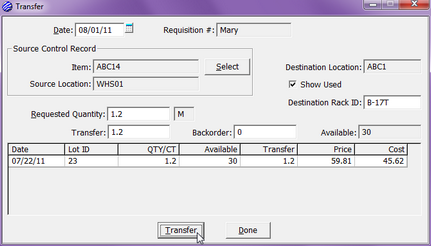
Click Transfer to carry out the transfer. After the system finishes processing the transfer, click the Select button to transfer another item.
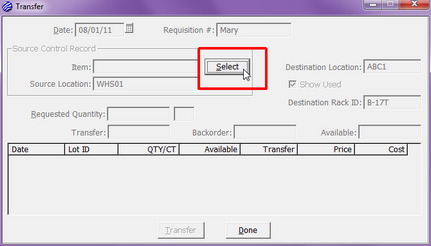
Mary didn’t remember the number for the next item. She simply told us to ship 2 cartons of their 4-part Service Invoice.
Click the Master Customer: prompt and set it to ABC.
Click Search on the Pick a Source Control Record dialog box.
Select the Service Invoice from the list box that is displayed.
Enter 1.2<Tab> for the Requested Quantity.
Click Transfer to carry out the transfer.
Click Done to close the Transfer dialog.
Click Yes to view the release document information.
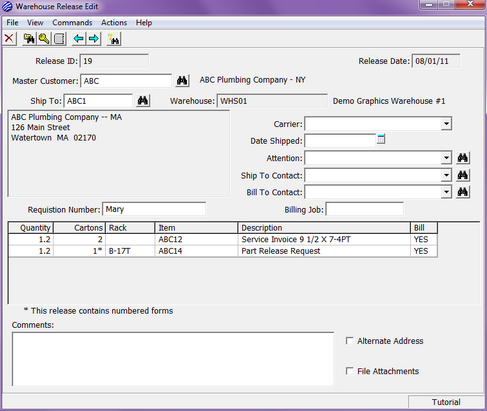
Notice the asterisk indicating that the Part Release Request is a numbered form. Double-click on this item in the list box to initiate the Release Document Activity Edit dialog.
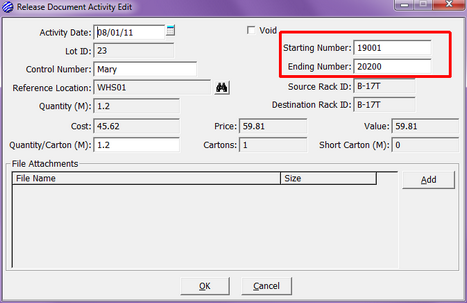
Xebra has automatically calculated the starting and ending numbers based on previous activity. Operators should check this numbering to assure that it is correct. Close the Release Activity Edit window.
Select Actions > Print Release Document from the Warehouse Release Edit dialog.
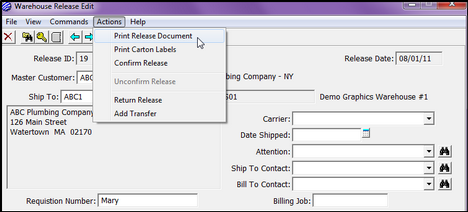
After reviewing the information on the Release Document, close the Print Preview and return to the Warehouse Release Edit window.
Print the Carton Labels
Hold down the Ctrl key and click on each of the lines in the list box. (Items ABC12 and ABC14). They will be highlighted to indicate that they have been selected.
Select Actions > Print Carton Labels.
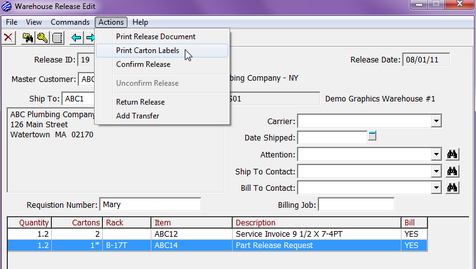
Enter Mary in the Attention prompt on the Carton Label Information dialog for the Service Invoice. In the case of ABC12, two cartons are being released, and while they are shipping simultaneously, they will be shipped as separate cartons. We would like a carton label for each of these. To do this, adjust the Number To Print field on the Carton Label Information dialog from 1 to 2 and check the Firm Counting option to the right. This will now provide us with 2 labels for this item; one representing Carton 1 of 2, and one representing 2 of 2. For ABC14, there is only 1 carton being sent, so you can simply enter Mary in the Attention prompt, and click OK.
After viewing the carton labels, close the Print Preview and return to the Warehouse Release Edit window.
At this point, the release document and carton labels would be sent to the warehouse for shipping. It could be directed to a printer in the warehouse, direct faxed to a fax machine in a warehouse that does not have a full time connection to your network, or printed and sent to the warehouse. The warehouse staff would provide the hand-fill information and return the release document to the office when the shipment has been completed. The document message area at the bottom of the document could be used to add a signature block so the document could be used as either a bill-of-lading or a delivery receipt, depending on your operation.
Confirm the Release and Create the Billing Job
Assume that we direct faxed the release request to the warehouse. Shortly thereafter, they picked the order and faxed the release document back to us.
Select Actions > Confirm Release from the Warehouse Release Edit dialog.
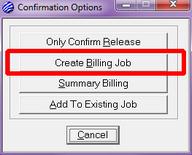
Select Create Billing Job from the Confirmation Options dialog.
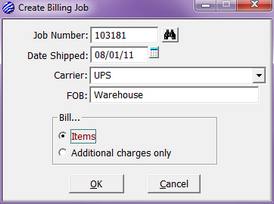
Accept the Date Shipped.
Enter UPS for the Carrier.
Enter Warehouse for the FOB.
Leave the ¤ Bill > Item(s) option button flagged.
Click OK to close the dialog box.
The program now switches you to the Order Entry Node with the newly created job displayed. At this point, we could add any additional charges and prepare the customer invoice.